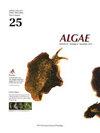盐度和光照对四孢子体灰葡萄(Halymeniacee,Rhodophyta)早期发育的影响
IF 2.4
3区 生物学
Q1 MARINE & FRESHWATER BIOLOGY
引用次数: 0
摘要
图氏Grateloupia turuturu是一种红色藻类,有一个扁平但坚硬光滑的铊。在其一生中,这种藻类在潮间带岩石海岸经历了广泛的环境压力。本研究的目的是研究盐度和光照对土霉四孢子体早期发育阶段的影响。释放的车皮孢子在不同的盐度(S=15、25和35)和辐照(50、100和200μmol光子m-2 S-1)下培养。每隔5天观察一次车皮孢子的萌发和幼四孢子体的发育,并用数码相机记录。在所有条件下,5天内形成盘状结壳。200μmol光子m-2 s-1的盘状结壳在20天内死亡,与盐度无关。S=35的盘状结壳在所有辐照条件下也在25天内死亡。除了在S=35和200μmol光子m-2 S-1时,盘状结壳在第20天达到约8000–9000μm2。在不考虑辐照度的情况下,在S=15和S=25时,盘状结壳的直立铊形成率分别为85%和10%。这些结果表明,盐度和辐照度是影响土霉早期发育的重要因素。本文章由计算机程序翻译,如有差异,请以英文原文为准。
Effects of salinity and irradiance on early developmental stages of Grateloupia turuturu (Halymeniaceae, Rhodophyta) tetrasporophytes
Grateloupia turuturu is a red alga with a flat but firm slippery thallus. Throughout its lifetime, this alga experiences a wide range of environmental stresses in the intertidal rocky shores. The aim of this study is to investigate the effect of salinity and irradiance on the early developmental stages of G. turuturu tetrasporophytes. The released carpospores were cultivated at different salinities (S = 15, 25, and 35) and irradiances (50, 100, and 200 μmol photons m-2 s-1). Germination of carpospores and development of juvenile tetrasporophytes were observed every 5 days and recorded by a digital camera. Discoid crusts were formed at all conditions within 5 days. The discoid crusts at 200 μmol photons m-2 s-1 died within 20 days regardless the salinity. The discoid crusts at S = 35 also died at all irradiance conditions within 25 days. Except for those at S = 35 and 200 μmol photons m-2 s-1, the discoid crusts reached about 8,000–9,000 μm2 by day 20. Regardless of irradiance, the upright thalli formation rate from discoid crusts was 85 and 10% at S = 15 and S = 25, respectively. These results suggest that salinity and irradiance are important factors influencing early developmental stages of G. turuturu.
求助全文
通过发布文献求助,成功后即可免费获取论文全文。
去求助
来源期刊

Algae
PLANT SCIENCES-
CiteScore
5.10
自引率
25.00%
发文量
18
期刊介绍:
ALGAE is published by the Korean Society of Phycology and provides prompt publication of original works on phycology. ALGAE publishes articles on all aspects of phylogenetics and taxonomy, ecology and population biology, physiology and biochemistry, cell and molecular biology, and biotechnology and applied phycology. Checklists or equivalent manu-scripts may be considered for publication only if they contribute original information on taxonomy (e.g., new combinations), ecology or biogeography of more than just local relevance. Contributions may take the form of Original Research Articles, Research Notes, Review Articles and Book Reviews.
 求助内容:
求助内容: 应助结果提醒方式:
应助结果提醒方式:


